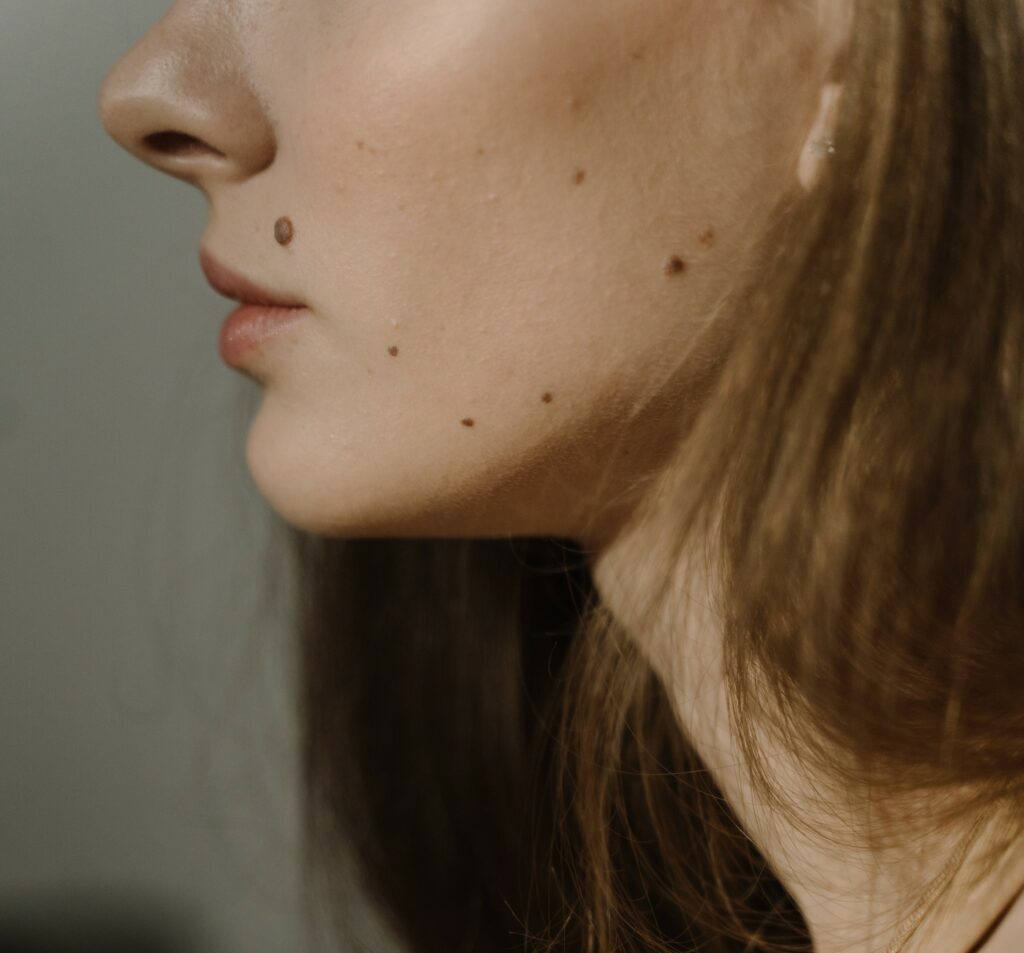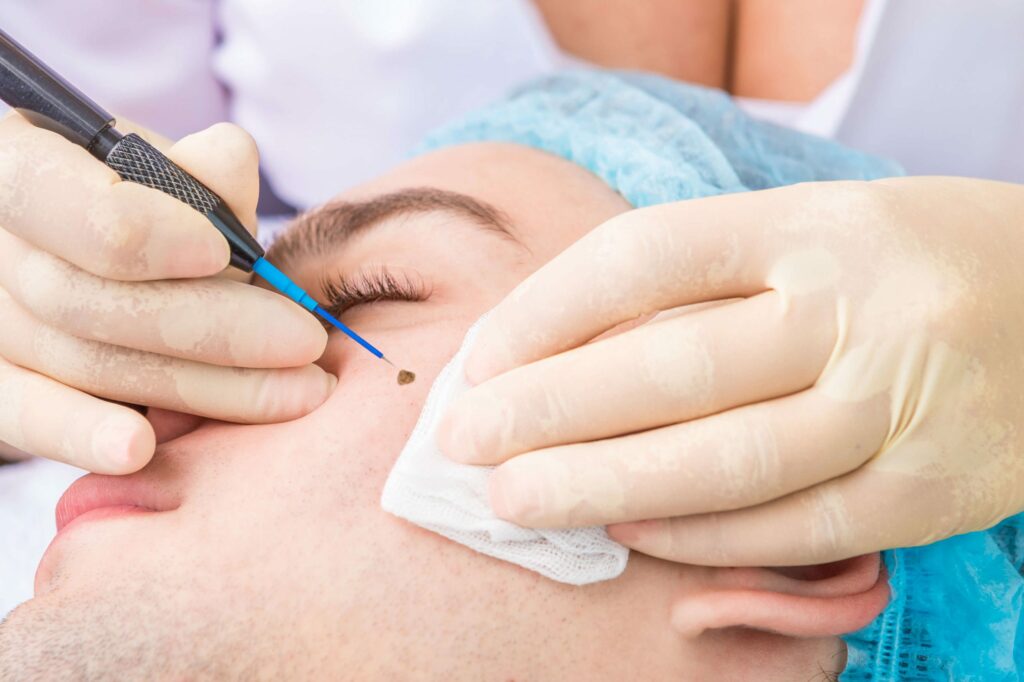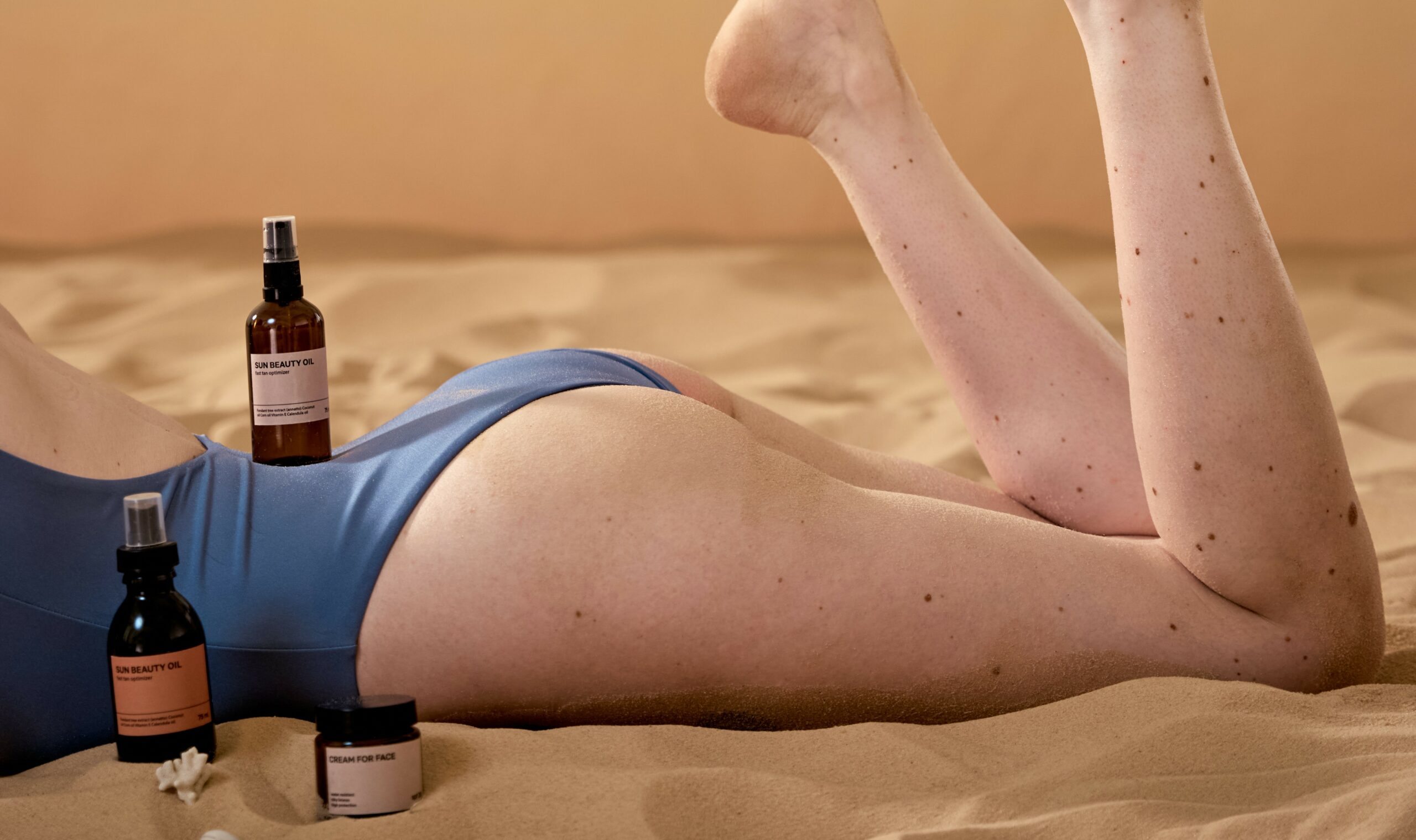Moles, also known as nevi, are clusters of pigmented cells that appear as dark spots on the skin. They can vary in size, color, and shape, and may be present at birth or develop throughout one’s lifetime. Moles are generally harmless, but some types can pose a higher risk of developing into skin cancer.
They are growths that occur when melanocytes, the cells responsible for producing skin pigment, grow in clusters instead of spreading throughout the skin. These clusters give rise to the characteristic dark coloration and can appear anywhere on the body and vary in size, ranging from tiny specks to larger, more noticeable spots.
Types of Moles
Congenital Moles
Congenital moles are present at birth and are often referred to as birthmarks. These occur when melanocytes develop in the skin before birth. So they can vary in size and shape, with some being relatively small while others are larger and more prominent.
Acquired Moles
Acquired moles, as the name suggests, develop after birth and are more common than congenital moles. They typically appear during childhood or adolescence and may continue to develop throughout adulthood. These spots can be influenced by factors such as sun exposure and hormonal changes.
Atypical Moles
Atypical moles, also known as dysplastic nevi, are moles that exhibit abnormal characteristics compared to regular ones. They often have irregular borders, uneven coloration, and a larger size. The Atypical may be hereditary, and individuals with numerous of these have an increased risk of developing melanoma.
Causes
The reason why moles appear on our skin is not completely known, but there are beliefs that they arise from a mix of genetic factors and exposure to sunlight. People with fair skin and a family background of moles are more prone to developing them. Also, if you spend too much time under the sun while not using sunscreen or other forms of protection, or using tanning beds, which emit ultraviolet radiation, can increase their number on the surface of the skin.
Symptoms and Identification
Moles can vary in appearance, but there are common characteristics to look out for when identifying them:

Shape, Color, and Size
Most are round or oval in shape, with smooth and defined borders. They typically have a uniform color, ranging from tan to dark brown, but can also be pink, red, or black. The size of them can range from a tiny dot to larger than a pencil eraser.
Changes in Moles
While most moles are harmless, certain types can develop into skin cancer, particularly melanoma. Melanoma is a serious and potentially life-threatening form of skin cancer. To help identify potentially cancerous moles, dermatologists often use the ABCDE rule:
- A: Asymmetry: Normal moles are usually symmetrical, meaning if you draw a line through the middle, both halves will look the same. Asymmetrical moles may be a cause for concern.
- B: Border irregularity: Moles with uneven or blurry borders can indicate potential issues. Watch out for irregular, scalloped, or jagged edges.
- C: Color variation: Moles that have multiple colors or uneven pigmentation might be atypical. Look for shades of brown, black, red, blue, or white within a mole.
- D: Diameter: Moles larger than 6 millimeters (about the size of a pencil eraser) may require further examination.
- E: Evolution: Any changes in the size, shape, color, or elevation of a mole over time should be monitored closely.
If you notice any of these characteristics in your moles, it’s important to consult a dermatologist for a thorough evaluation.
Treatment Options

The majority of moles do not require treatment unless they pose a risk or cause discomfort. However, some individuals may opt for mole removal for cosmetic reasons or due to suspicion of skin cancer. Common treatment options include:
Excision
Excision involves surgically removing the mole along with a surrounding margin of healthy skin. This method is often used for larger moles or those suspected to be cancerous. The procedure is typically performed under local anesthesia, and the removed mole is sent to a laboratory for further examination.
Shave Removal
Shave removal is a procedure where the mole is shaved off at the skin’s surface using a scalpel or specialized tool. This method is suitable for raised moles or those that do not penetrate deeply into the skin. It may not require stitches, and scarring is minimal.
Laser Surgery
Laser surgery is an option for removing certain types of moles. It involves using laser energy to break down the pigment in the mole, gradually lightening or eliminating it. Laser surgery is typically reserved for smaller, non-cancerous moles.
It’s important to consult with a dermatologist to determine the most suitable treatment option based on the type, location, and characteristics of your moles.
Prevention and Self-Examination

While it’s not possible to prevent the development of all moles, there are steps you can take to reduce your risk and promote overall skin health. Here are some preventive measures and self-examination tips:
Sun Protection
Protect your skin from harmful UV radiation by wearing sunscreen with a high SPF, seeking shade during peak sun hours, and wearing protective clothing, such as hats and long sleeves.
Avoid Tanning Beds
Avoid the use of tanning beds and sunlamps, as they emit UV radiation that can damage the skin and increase the risk of developing moles and skin cancer.
Regular Self-Examinations
Perform regular self-examinations to monitor your moles and identify any changes. Use a mirror or ask a partner to help examine areas that are difficult to see, such as your back and scalp.
Follow the ABCDE Rule
Familiarize yourself with the ABCDE rule mentioned earlier and assess your moles for any warning signs.
Protect Children
Take extra care to protect children from excessive sun exposure, as sunburns during childhood can increase the risk of developing moles and skin cancer later in life.
When to See a Dermatologist
While most moles are harmless, it’s important to consult a dermatologist if you notice any concerning changes or if you have a higher risk of developing skin cancer. Seek medical attention if you experience:
- New moles that appear after the age of 30.
- Changes in the size, shape, color, or elevation of existing moles.
- Moles that itch, bleed, or become painful.
- Development of atypical moles or a family history of melanoma.
- Any other worrisome symptoms related to your moles.
A dermatologist can perform a thorough examination, provide an accurate diagnosis, and recommend appropriate treatment or further testing if necessary.
Tips for Healthy Skin
In addition to monitoring your moles, adopting a skincare routine that promotes overall skin health is essential. Here are some tips for maintaining healthy skin:
- Cleanse and Moisturize: Cleanse your skin gently using a mild cleanser and moisturize daily to keep your skin hydrated and nourished.
- Eat a Balanced Diet: Incorporate a variety of fruits, vegetables, lean proteins, and whole grains into your diet to provide essential nutrients for healthy skin.
- Stay Hydrated: Drink an adequate amount of water each day to keep your skin hydrated from within.
- Get Sufficient Sleep: Aim for 7-8 hours of quality sleep each night to allow your skin to repair and regenerate.
- Manage Stress: Practice stress-management techniques such as exercise, meditation, or hobbies to reduce stress levels, as prolonged stress can affect your skin’s health.
Remember, healthy skin goes beyond just monitoring moles. Taking care of your overall skin health contributes to a vibrant and radiant complexion.
Frequently Asked Questions (FAQs)
- Can moles disappear on their own?
- While it’s rare, some can fade or disappear over time. However, it’s important to consult a dermatologist if you notice any changes.
- Are all moles cancerous?
- No, the majority of moles are benign and not cancerous. However, it’s important to monitor them for any changes or suspicious characteristics.
- Can moles develop during adulthood?
- Yes, moles can develop at any age. New moles can appear in adulthood due to various factors, such as hormonal changes or sun exposure.
- How can I protect my skin from moles?
- Protect your skin from excessive sun exposure by wearing sunscreen, seeking shade, and wearing protective clothing.
- Can moles be removed without scarring?
- The extent of scarring after mole removal depends on various factors. It’s best to consult with a dermatologist to discuss the most suitable removal technique for your specific dark spot.



